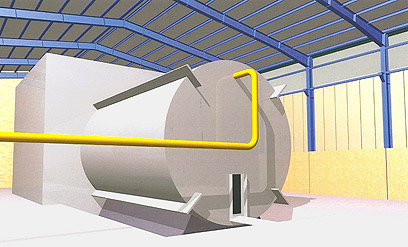Image from inside Iranian military site shows type of explosives containment chamber needed for nuclear tests. Former IAEA official: Drawing is accurate
An image said to come from inside an Iranian military site shows an explosives containment chamber of the type needed for nuclear arms-related tests that UN inspectors suspect Tehran has conducted at the site. Iran denies such testing and has neither confirmed nor denied the existence of such a chamber.
The image was provided to The Associated Press by an official of a country tracking Iran’s nuclear program who said the drawing proves the structure exists, despite Tehran’s refusal to acknowledge it.
The official said he could not discuss the drawing’s origins beyond that it was based on information from a person who had seen the chamber at the Parchin military site, adding that going into detail would endanger the life of that informant.
His country, a member of the International Atomic Energy Agency, is severely critical of Iran’s assertions that its nuclear activities are peaceful and asserts they are a springboard for making atomic arms.

Image said to come from inside Iranian military site (Photo: AP)
A former senior IAEA official said he believes the drawing is accurate. Olli Heinonen, until last year the UN nuclear agency’s deputy director general in charge of the Iran file, said it was “very similar” to a photo he recently saw that he believes to be the pressure chamber the IAEA suspects is at Parchin. He said even the colors of the drawing matched that of the photo.
After months of being rebuffed, IAEA and Iranian officials meet starting Monday in Vienna, and the IAEA will renew its attempt to gain access to the chamber, allegedly hidden in a building. Any evidence that Iran is hiding such an explosives containment tank, and details on how it functions, is significant for IAEA investigations.
Beyond IAEA hopes of progress, that two-day meeting is being closely watched by six powers trying to persuade Iran to make nuclear concessions aimed at reducing fears that it may want to develop atomic arms as a mood-setter for May 23 talks between the six and Tehran in Baghdad.
The IAEA has been stonewalled by Iran for more than four years in attempts to probe what it says is intelligence from member states strongly suggesting that Iran secretly worked on developing nuclear weapons.
It first mentioned the suspected existence of the chamber in a November report that described “a large explosives containment vessel” for experiments on triggering a nuclear explosion, adding that it had satellite images “consistent with this information.”
It did not detail what the images showed. But a senior diplomat familiar with the IAEA’s investigation who has also seen the image provided to the AP said they revealed a cylinder similar to the image at Parchin. Subsequent photos showed a roof and walls going up around the cylinder that then hid the chamber from satellite surveillance.
IAEA chief Yukiya Amano said in March that his agency has “credible information that indicates that Iran engaged in activities relevant to the development of nuclear explosive devices” at the site. Diplomats subsequently told the AP that the experiments also appear to have involved a small prototype neutron device used to spark a nuclear explosion – equipment that would be tested only if a country was trying to develop atomic weapons.
Iran has strenuously denied conducting such work – and any intentions to build nuclear weapons – but has been less clear on whether the structure where it allegedly took place exists.
No comment from Iran
The senior diplomat familiar with the IAEA investigations said the Iranians have refused to comment “one way or the other” on that issue to agency experts. He and others interviewed by the AP demanded anonymity because their information was privileged, and the official providing the drawing and other details on the structure also demanded that he and his country not be identified in return for sharing classified intelligence.
Attempts to get Iranian comment were unsuccessful. A copy of the diagram was attached to an email sent to Ali Asghar Soltanieh, Iran’s chief delegate to the IAEA, with a note that the AP would be asking for reaction. Subsequent phone calls over the weekend went to his voice mail.
The technology used for the suspected multipoint explosives trigger experiments is similar to that employed in manufacturing tiny industrialized diamonds, and the IAEA believes former Soviet scientist Vyacheslav Danilenko – an expert in such diamond-making _ helped Iran with designing the chamber.
Diplomats say Danilenko has told the agency that he did not work on such a chamber, but his son in law, identified by the diplomats as Vladimir Padalko, told the IAEA that the container was built under Danilenko’s direct supervision. Repeated attempts by the AP and other media organizations to contact the two men have been unsuccessful since the IAEA revealed Danilenko’s suspected involvement in November.
View Source
By The Associated Press







 Israeli New Shekel Exchange Rate
Israeli New Shekel Exchange Rate